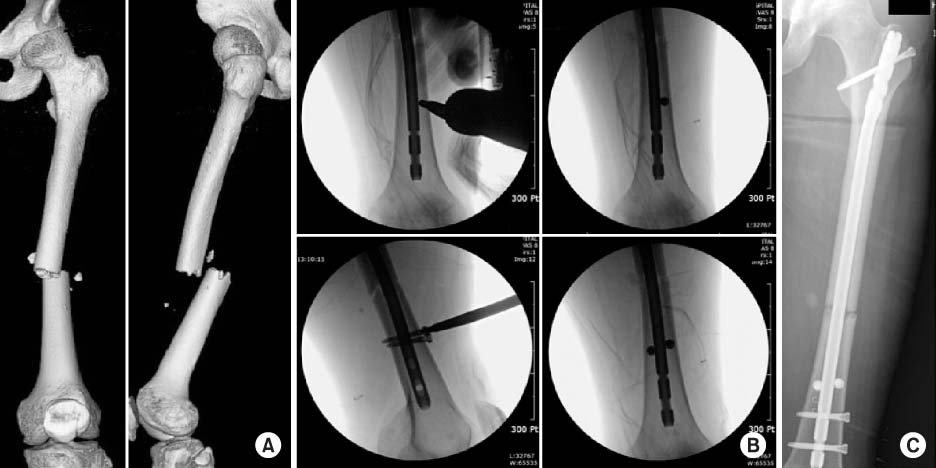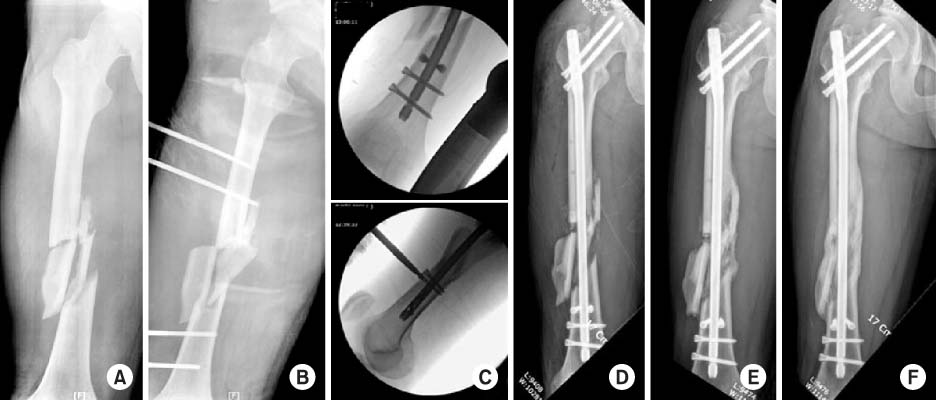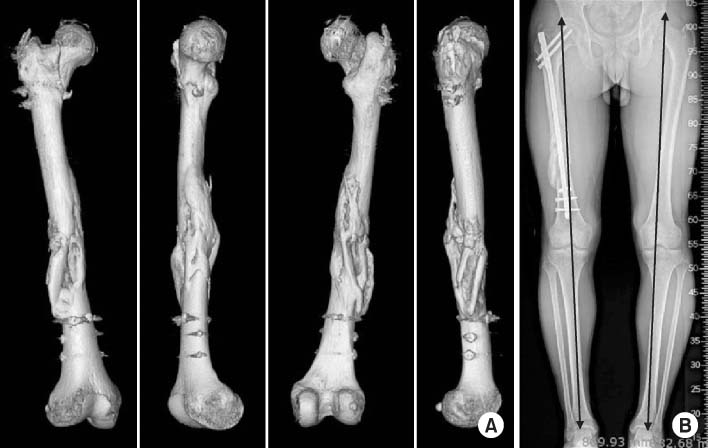J Korean Fract Soc.
2015 Oct;28(4):230-236. 10.12671/jkfs.2015.28.4.230.
The Usefulness of Poller Screw with Antegrade Nailing in the Initial Treatment of Infraisthmal Femur Shaft Fracture
- Affiliations
-
- 1Department of Orthopedic Surgery, Myongji Hospital, Seonam University College of Medicine, Goyang, Korea. sh.gabriel.song@gmail.com
- KMID: 2070349
- DOI: http://doi.org/10.12671/jkfs.2015.28.4.230
Abstract
- PURPOSE
The purpose of this study was to evaluate the radiologic and clinical outcomes after intramedullary nailing with Poller screw insertion at initial stage in infraisthmal femur shaft fractures.
MATERIALS AND METHODS
Seven consecutive patients (7 femurs) treated with antegrade intramedullary nailing with Poller screw insertion for the infraisthmal femur shaft fracture were reviewed retrospectively. There were 4 male and 3 female patients. Mean age was 46.1 years (20-72 years). Operative time including Poller screw insertion, time for union, malalignment, and range of motion were evaluated.
RESULTS
All 7 cases had primarily healed successfully. Mean time for radiologic union was 19.1 weeks (16-24 weeks) postoperatively. One case had 5 degree valgus malalignment. One case of 15 mm shortening was reported and he required shoe lift orthosis. All cases had a full range of motion in hip and knee joint.
CONCLUSION
Antegrade intramedullary nailing with Poller screw insertion is useful in the initial treatment of infraisthmal femur shaft fracture, because it could provide additional stability. An additional 20 minutes were required but a Poller screw should be considered according to the anatomic location of a femur shaft fracture.
Keyword
MeSH Terms
Figure
Reference
-
1. Bucholz RW, Jones A. Fractures of the shaft of the femur. J Bone Joint Surg Am. 1991; 73:1561–1566.
Article2. Weiss RJ, Montgomery SM, Al Dabbagh Z, Jansson KA. National data of 6409 Swedish inpatients with femoral shaft fractures: stable incidence between 1998 and 2004. Injury. 2009; 40:304–308.
Article3. Wolinsky PR, McCarty E, Shyr Y, Johnson K. Reamed intramedullary nailing of the femur: 551 cases. J Trauma. 1999; 46:392–399.4. Pihlajamäki HK, Salminen ST, Böstman OM. The treatment of nonunions following intramedullary nailing of femoral shaft fractures. J Orthop Trauma. 2002; 16:394–402.
Article5. Brumback RJ. The rationales of interlocking nailing of the femur, tibia, and humerus. Clin Orthop Relat Res. 1996; (324):292–320.
Article6. Kessler SB, Hallfeldt KK, Perren SM, Schweiberer L. The effects of reaming and intramedullary nailing on fracture healing. Clin Orthop Relat Res. 1986; (212):18–25.
Article7. Yang KH, Kim JR, Park J. Nonisthmal femoral shaft nonunion as a risk factor for exchange nailing failure. J Trauma Acute Care Surg. 2012; 72:E60–E64.
Article8. Krettek C, Rudolf J, Schandelmaier P, Guy P, Könemann B, Tscherne H. Unreamed intramedullary nailing of femoral shaft fractures: operative technique and early clinical experience with the standard locking option. Injury. 1996; 27:233–254.
Article9. Stedtfeld HW, Mittlmeier T, Landgraf P, Ewert A. The logic and clinical applications of blocking screws. J Bone Joint Surg Am. 2004; 86:Suppl 2. 17–25.
Article10. Park J, Kim SG, Yoon HK, Yang KH. The treatment of nonisthmal femoral shaft nonunions with im nail exchange versus augmentation plating. J Orthop Trauma. 2010; 24:89–94.
Article11. Kim JJ, Kim SK, Ahn JH. the use of poller screws in nonunion of femoral shaft following intramedullary nailing of femoral shaft fracture: a case report. J Korean Orthop Assoc. 2005; 40:1024–1027.
Article
- Full Text Links
- Actions
-
Cited
- CITED
-
- Close
- Share
- Similar articles
-
- The Use of Poller Screws in Nonunion of Femoral Shaft Following Intramedullary Nailing of Femoral Shaft Fracture: A Case Report
- Nonunion of the Fracture of Distal One-third of Femoral Shaft treated by Interlocking Intramedullary Nailing
- Treatment of Proximal Shaft Fracture of Tibia with Intramedullary Nail: Analysis According to AO Classification and the Poller Screw
- Delayed Pseudoaneurysm of the Femoral Artery after Intramedullary Nailing of a Femur Shaft Fracture
- Treatment of Femur Shaft Fracture by Intrlocking Intramedullary Nailing




